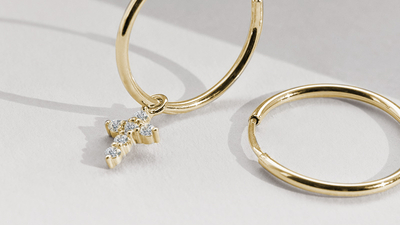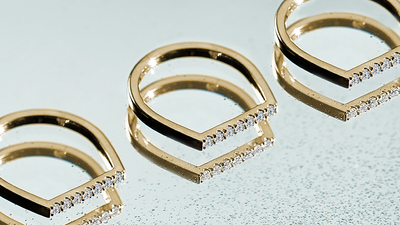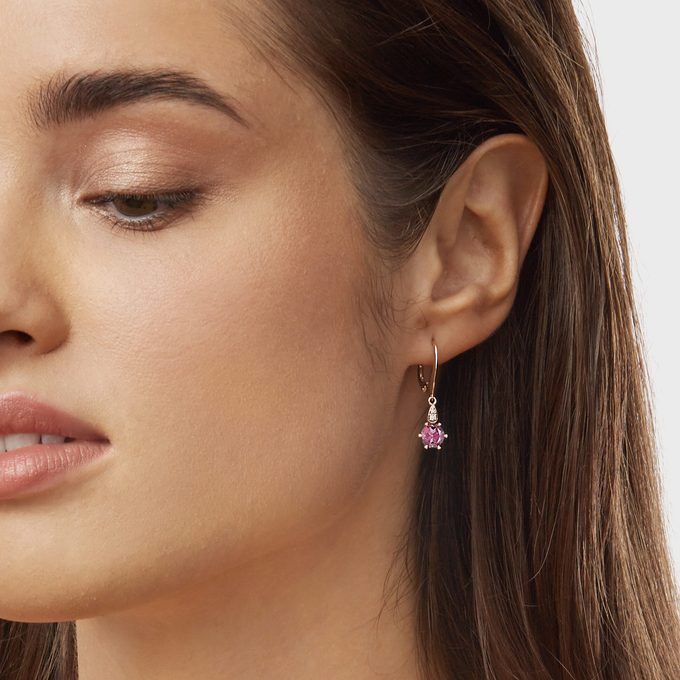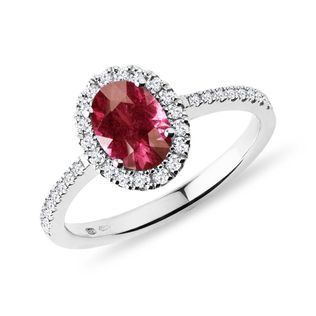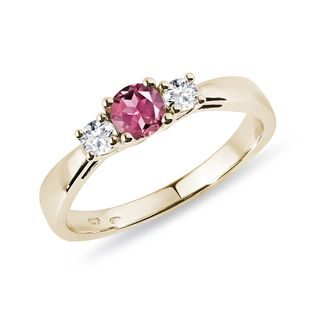Tourmaline is a beautiful mineral which is attractive mainly thanks to its colors. Its name comes from Sri Lanka’s Singhalese tribe, which calls it toramalli. It means “a stone that gets dirty with particles of ashes.” According to another interpretation, it means “a stone of mixed colors” or “mixed gemstones.”
This name originated in the 15th century, when a certain Spanish conquistador found a green stone in Brazil. He thought it was an emerald. His mistake was considered to be truth until the 18th century when scientists discovered it was in fact a different, new kind of mineral. Thus the name “tourmaline” also refers to the chaos which preceded the correct classification of this stone. In India, the name thoramalli, i.e. “covered in dust,” was used. Tourmalines came to Europe from Sri Lanka in the 18th century.
Ancient Egyptians knew tourmalines very well. They believed the stones were so colorful because they travelled to Earth along a rainbow, picking up their colors from the rainbow on their journey.
Traditions and legends connected to tourmalines
Traditions say that rubellites, a pinkish-red kind of tourmaline, are good for women. Their color is said to symbolize desire and seduction. Rubellites emit a great erotic charge, and a woman who wears jewels with rubellites is said to enjoy life and have a healthy sex drive. Besides women, rubellites are supposed to have a positive influence on artists, as they stimulate their artistic talents and inspiration. Therefore, they have long been worn as talismans.
Watermelon tourmalines strengthen love and the courage to commit to another person. Blue tourmalines are supposed to stimulate the urge for spiritual freedom and self-expression and boost one’s fidelity, tolerance, and love for the truth. Green tourmalines promote compassion, tenderness, patience, and a sense of belonging together. They are said to have the power to transform negative things into positive and to dispel fears and worries. In India, colorful tourmalines are assigned to individual chakras, which they both influence and connect at the same time.
In astrology, tourmalines belong to the signs of Libra, Scorpio, and Pisces. In the calendar, they are associated with the month of October. Therefore, women born in this month will be especially pleased with a present in the form of a tourmaline ring, earrings or a necklace.

Tourmaline properties from a scientific point of view
Tourmalines are cyclic silicates. More specifically, they are borosilicates of aluminium and other elements. They crystallize in the trigonal system. They are typically minerals of granite and pegmatite rocks. Less often, they may be formed in metamorphic rocks or Alpine or hydrothermal veins. Secondarily, they occur in sediments.
They create platy crystals (schorls): prismatic or needle-like, grooved crystals which have a triangular cross-section. They can both coat a surface as well as be ingrown and can grow up to 1 meter long with various thicknesses. The crystals often create various aggregates, arranged either irregularly or radially. Radially arranged crystals are called tourmaline suns.
The chameleon among gems
Tourmalines’ chemical structure makes them a very complicated mineral. In its formula, there are 6 places which can be occupied by various elements, such as sodium, iron, lithium, magnesium, and others. Tourmalines are truly variable gemstones, probably the most complicated of all. Within one crystal, we might find spots with different chemical composition, meaning the crystal gradually changed as it grew. Therefore, it is very difficult to determine the kind of a specific tourmaline out of the fourteen total types. They can really only be distinguished with a chemical analysis.
So, it creates various colorful or even multi-colored variants. Examples include watermelon tourmalines or tourmalines with black tops. Tourmalines also might differ in the degree of transparency. An interesting phenomenon is zonation, which is caused by the variability of the composition. There might be different shades of colors or even different colors arranged in zones in a single crystal.
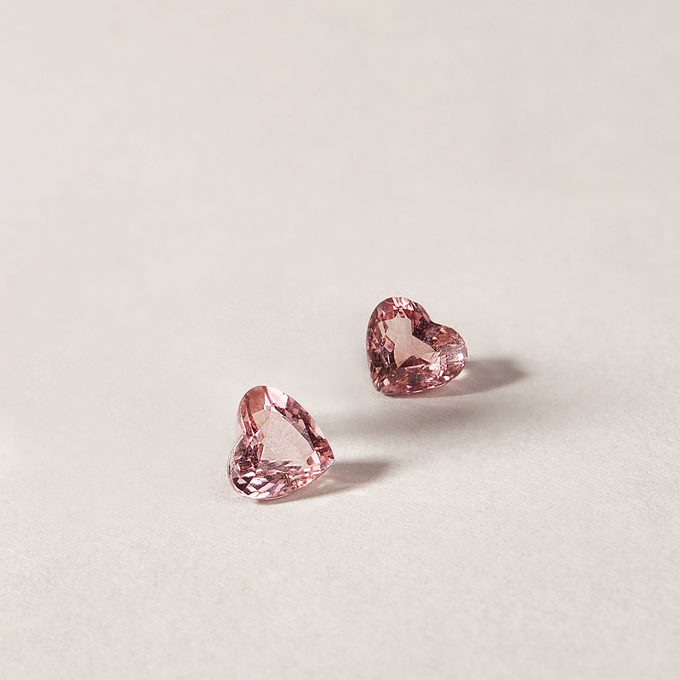
What is common among all tourmalines
Physical properties connect all tourmalines. They are fragile and have a hardness of 7–7.5. A tourmaline’s cleavage is indistinct. It has conchoidal fracture and vitreous luster. The streak is white but with the various shades of its specific variety. They are often pleochroic (by changing the angle of the light, the intensity of the color or the coloration inside the stone seems to change).
Tourmalines cannot be dissolved in acids. An interesting fact is that by applying heat and friction, the ends of the crystals become charged with opposite electrical charges. They are piezoelectrical and pyroelectric, which means they attract particles of dust and ashes. In the Earth’s crust, tourmalines are the main bearers of boron. They can be etched by hydrofluoric acid. Sometimes, a cat’s eye effect may occur in tourmalines.
Tourmaline groups and varieties
GIA, i.e. the Gemological Institute of America, differentiates between several tourmaline varieties which are classified in groups:
ELBAITES
The first and probably also the most famous group are elbaites, which are rich in lithium, and all the well-known colorful varieties belong to this group. They form series with another group: schorls. Among others, this group includes green verdelites, pinkish-red rubellites, blue indicolites, or a two-colored variety of watermelon tourmalines (its crystals are a combination of green and pink hues: one color forms the inner zone and the other the outer zone – the cross-section of the mineral then resembles a watermelon) which are used in jewelry-making. Other elbaites are achroites, paraíbas, olenites, or rossmanites.
Lovers of unique gems might find the paraíba variety interesting. Its turquoise color, caused by copper, distinguishes it from other tourmalines. It also occurs in purple and blue variants. It is a rare mineral which originally comes from Brazil. Nowadays, all of its known deposits are mined out, so it’s almost impossible to buy it on the market. Its price is really high, around 4,000 USD per carat.
As you can see, elbaites are the most variable group of tourmalines. They are also in the hands of gemcutters most often and are most often used in jewelry-making.
DRAVITES
The second group is dravites which are colored mainly by magnesium, sodium, and aluminium. We can find them in some marble rocks or dolomites, and sometimes also in igneous rocks and some pegmatites or schists. They form series with uvites and schorls. Dravites, chromdravites, and vanadiumdravites belong to this group. From this group, cut dravites with brown to orange coloring are most commonly used in jewelry-making. In this group, we can often see dichroism (two colors).
UVITES
The third group is the so-called uvites. These are hardly ever cut. They mostly get their color from magnesium, aluminium, or calcium. They form rather short platy crystals and are often mixed with dravites. Uvites and feruvites belong to this group. They are most commonly found in dolomites and limestones. Vividly green tourmalines come from Burma, and golden-brown crystals come from Sri Lanka.
SCHORLS
The next group contains the tourmalines which are most common in nature: schorls. They are usually black and opaque. Rarely, some pieces which are brown-black, blue-black, or even more rarely blue can be translucent. They are colored by iron and sodium. They are very often mixed with dravites. There are several varieties, mainly schorls, buergerites, foitites, magnesiofoitites, and povondraites.
LIDDICOATITE
The last group or kind of tourmaline is liddiocoatite. These tourmalines are very rich in calcium, lithium, and aluminium. They are very variable with regard to color – they are the most colorful stones of all tourmalines. They form pink, green, and green-brown to yellow-brown crystals. They are found in granitic igneous rocks. Formerly, large crystals were found, cut into little plates, and then burnished. Such a plate had a full range of colors. These days, such plates are rare and very expensive. The deposit in Madagascar was mined out. We can also see faceted cuts, which are always done in such a way as to best showcase as many of the stone’s colors as possible.
KLENOTA tourmaline jewelry
Finding another gem which would naturally include various shades of colors or even different colors in a single crystal would be hard. Therefore, it is often very difficult to even find two pieces with the same colors. If you purchase tourmaline jewelry, you can be sure you have a real original.
With the popularity of tourmalines in the world, the demand rapidly increased. This is the reason why some deposits are already empty and others will soon share the same fate. With this, the price of tourmalines has also increased quite rapidly. Therefore, if you wish to own this gemstone, the best day to make the purchase is today. KLENOTA mainly offers pink tourmalines in white and yellow gold and red-pink rubellites in white gold. By choosing a combination with diamonds, you will get a jewel that stands out in every way.
Tourmalines are most often cut into round or oval shapes. Drop-shaped cuts are also very fashionable.
How to take care of tourmalines
Tourmalines happily attract particles of dust; therefore, their maintenance and cleaning is trickier. We recommend keeping the jewelry in a box when you aren’t wearing it. Even though they are mechanically and chemically quite resistant, they are pretty fragile. This is caused by various cracks and inclusions which are often present in them. When the jewelry is handled properly, you don’t have to worry about the gem.
We definitely recommend taking off your tourmaline jewelry for housework. By that, you will significantly reduce the risk of damage. Cooking is also not good for tourmalines. Even though they can stand temperatures of up to 1290 °F, they might not do well with temperature shocks. Moreover, they can get dirty when cooking. A dirty stone loses its luster, and when it is cleaned improperly, it might be damaged.

Tourmalines from all over the world
Some of the significant tourmaline deposits are located in Africa, Afghanistan, Canada, Madagascar, the USA, Brazil, Sri Lanka, and other places. Rubellites are mostly found in Brazil, Madagascar, Mozambique, Nigeria, or Pakistan. The most beautiful pieces are mainly found in the USA. Indicolites come from northern Brazil, Nigeria, Afghanistan, or Pakistan.
Tourmalines can also be found in the Czech Republic. However, their quality is really only good for collectors. The discovery of two new varieties came from the town of Velké Meziříčí. The first one is an elbaite variety – rossmanite. Another discovery was povondraite named after the Czech tourmaline expert, Professor Povondra.
Records, interesting facts, and famous tourmalines
Tourmalines are not only used for jewelry. In China, statues or snuff bowls were made of them. Dutchmen used them for another unusual purpose. They called tourmalines popeltrekker and used them for pipe cleaning because of their pyroelectric properties.
Tourmalines are record-breakers when it comes to their length. Findings of schorls from Finland and Norway included columnar crystals which were 5 meters long. The largest rubellite crystal in the world was named The Rocket. It was found in the Jonas mine in Minas Gerais in Brazil, and it is 109 cm long and is awesome indeed. Another, slightly smaller piece is a rubellite called Tarugo. It was found in the same mine and is 90 cm long.
The Czech Crown of Saint Wenceslas is decorated by a large ruby... or so they said, until 1998 when the crown underwent a gemological analysis. It showed that there is actually a large rubellite in the crown. So, there isn’t a rare ruby in the Czech crown, but it is probably one of the oldest rubellites used in jewelry-making. The Czech crown jewels weren’t the only ones in which rubellites were mistaken for rubies. The same thing happened to the Russian crown jewels as well as the “ruby” of Rudolf II, the emperor.



